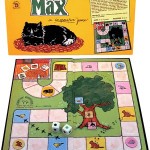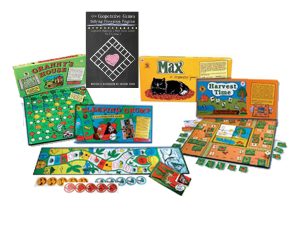Cooperative games are a relatively new kind of play—these are games based on cooperation rather than competition. In a cooperative game, no one is ever eliminated. Players bond with one another as they  enjoy shared fun without worrying that others may be proven to be luckier or “better†than they are. While competitive games often produce psychological threat—especially in children—cooperative games invite us to relax and have fun without anxiety. There are cooperative games of all kinds for all ages and settings. They range from board games to circle games to PE games to online games and more. They are all based on the understanding that it can be just as much fun—well, actually more fun—to play with each other than against each other!
enjoy shared fun without worrying that others may be proven to be luckier or “better†than they are. While competitive games often produce psychological threat—especially in children—cooperative games invite us to relax and have fun without anxiety. There are cooperative games of all kinds for all ages and settings. They range from board games to circle games to PE games to online games and more. They are all based on the understanding that it can be just as much fun—well, actually more fun—to play with each other than against each other!
Social scientists tell us that competition is defined as an interaction between people such that a particular goal is sought by all, but only one individual or group can attain it. By contrast, cooperation is coordinated

effort directed at attaining a goal everyone can achieve by working together. Which of these modes of social interaction is more likely to result in mutual appreciation, respect, helpfulness and kindness? Which is more likely to result in defensiveness, anger, resentment, and envy? As we know from everyday life, common sense, and an increasing body of research, cooperation produces pro-social behavior while competition is often a recipe for social discord, unhappiness, jealousy, and even aggression.
Max the Cat, a Game that Embodies Kindness and CaringÂ
Consider Max the Cat, the classic cooperative board game for children ages 4-7. This game demonstrates how cooperative play can enable players to enjoy one another in kind and gentle—yet still fun and challenging—ways.
 In Max the Cat, players adopt the little creatures—a bird, mouse, and chipmunk. The little creatures’ goal is to travel all the way around the board to return to their home tree. Meanwhile Max, a fluffy black Tom Cat, rests on the porch. Players roll the dice when it is their turn. If they roll green dots, the little creatures move toward the home tree. But if players roll black dots, Max advances on the board. If Max lands on the same square as a bird, mouse, or chipmunk, the little creature becomes Max’s lunch!
How can the humans work together to keep the little creatures safe? One way is to lure Max back to his porch with the catnip, milk, cheese and favorite food tokens. But tokens

are scarce and need to be used judiciously—and that takes teamwork. A theme of the game is that Max is a natural hunter and it’s not fitting to hurt him or hate him. Better to coexist with him by luring him back to the porch where he can be happy without causing harm to others. To make this happen, players must be smart and work together by practicing their pro-social skills including taking turns, sharing, respectfully listening, and protecting the little creatures at the same time they even take care of Max. It’s a game based on a heart-centered paradigm. A whole new world—which feels great for one and all!
Using Cooperative Games Intentionally to Promote Kindness
If you would like to find out lots more about cooperative games and how they can be used to promote kindness at home and in the classroom, please visit my website CooperativeGames.com at https://cooperativegames.com/
We offer many free resources including a free ebook called Cooperative Games: Antidote to Excess

Competition, as well as coloring pages and directions for active games. We offer a carefully selected variety of cooperative board games for sale and we offer cooperative games programs and workshops
too. If you are a teacher or parent interested in social and emotional learning, you can also learn about a research-based approach to prevent bullying with cooperative games. See The Cooperative Games Bullying Prevention Program at https://cooperativegames.com/  It’s true, we are stronger—and happier—together!
Wishing you lots of love and laughter,
Suzanne Lyons MA, MA
Founder CooperativeGames.com
Â